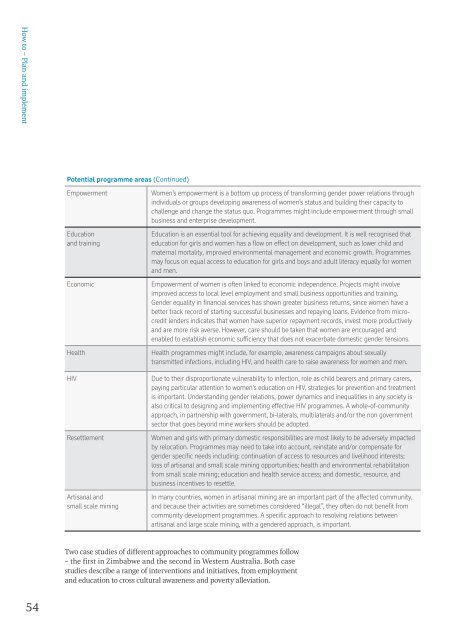Why gender matters - Centre for Social Responsibility in Mining ...
Why gender matters - Centre for Social Responsibility in Mining ...
Why gender matters - Centre for Social Responsibility in Mining ...
You also want an ePaper? Increase the reach of your titles
YUMPU automatically turns print PDFs into web optimized ePapers that Google loves.
How to – Plan and implement<br />
Potential programme areas (Cont<strong>in</strong>ued)<br />
Empowerment<br />
Education<br />
and tra<strong>in</strong><strong>in</strong>g<br />
Economic<br />
Health<br />
HIV<br />
Resettlement<br />
Artisanal and<br />
small scale m<strong>in</strong><strong>in</strong>g<br />
Women’s empowerment is a bottom up process of trans<strong>for</strong>m<strong>in</strong>g <strong>gender</strong> power relations through<br />
<strong>in</strong>dividuals or groups develop<strong>in</strong>g awareness of women’s status and build<strong>in</strong>g their capacity to<br />
challenge and change the status quo. Programmes might <strong>in</strong>clude empowerment through small<br />
bus<strong>in</strong>ess and enterprise development.<br />
Education is an essential tool <strong>for</strong> achiev<strong>in</strong>g equality and development. It is well recognised that<br />
education <strong>for</strong> girls and women has a flow on effect on development, such as lower child and<br />
maternal mortality, improved environmental management and economic growth. Programmes<br />
may focus on equal access to education <strong>for</strong> girls and boys and adult literacy equally <strong>for</strong> women<br />
and men.<br />
Empowerment of women is often l<strong>in</strong>ked to economic <strong>in</strong>dependence. Projects might <strong>in</strong>volve<br />
improved access to local level employment and small bus<strong>in</strong>ess opportunities and tra<strong>in</strong><strong>in</strong>g.<br />
Gender equality <strong>in</strong> f<strong>in</strong>ancial services has shown greater bus<strong>in</strong>ess returns, s<strong>in</strong>ce women have a<br />
better track record of start<strong>in</strong>g successful bus<strong>in</strong>esses and repay<strong>in</strong>g loans. Evidence from microcredit<br />
lenders <strong>in</strong>dicates that women have superior repayment records, <strong>in</strong>vest more productively<br />
and are more risk averse. However, care should be taken that women are encouraged and<br />
enabled to establish economic sufficiency that does not exacerbate domestic <strong>gender</strong> tensions.<br />
Health programmes might <strong>in</strong>clude, <strong>for</strong> example, awareness campaigns about sexually<br />
transmitted <strong>in</strong>fections, <strong>in</strong>clud<strong>in</strong>g HIV, and health care to raise awareness <strong>for</strong> women and men.<br />
Due to their disproportionate vulnerability to <strong>in</strong>fection, role as child bearers and primary carers,<br />
pay<strong>in</strong>g particular attention to women’s education on HIV, strategies <strong>for</strong> prevention and treatment<br />
is important. Understand<strong>in</strong>g <strong>gender</strong> relations, power dynamics and <strong>in</strong>equalities <strong>in</strong> any society is<br />
also critical to design<strong>in</strong>g and implement<strong>in</strong>g effective HIV programmes. A whole-of-community<br />
approach, <strong>in</strong> partnership with government, bi-laterals, multilaterals and/or the non government<br />
sector that goes beyond m<strong>in</strong>e workers should be adopted.<br />
Women and girls with primary domestic responsibilities are most likely to be adversely impacted<br />
by relocation. Programmes may need to take <strong>in</strong>to account, re<strong>in</strong>state and/or compensate <strong>for</strong><br />
<strong>gender</strong> specific needs <strong>in</strong>clud<strong>in</strong>g: cont<strong>in</strong>uation of access to resources and livelihood <strong>in</strong>terests;<br />
loss of artisanal and small scale m<strong>in</strong><strong>in</strong>g opportunities; health and environmental rehabilitation<br />
from small scale m<strong>in</strong><strong>in</strong>g; education and health service access; and domestic, resource, and<br />
bus<strong>in</strong>ess <strong>in</strong>centives to resettle.<br />
In many countries, women <strong>in</strong> artisanal m<strong>in</strong><strong>in</strong>g are an important part of the affected community,<br />
and because their activities are sometimes considered “illegal”, they often do not benefit from<br />
community development programmes. A specific approach to resolv<strong>in</strong>g relations between<br />
artisanal and large scale m<strong>in</strong><strong>in</strong>g, with a <strong>gender</strong>ed approach, is important.<br />
Two case studies of different approaches to community programmes follow<br />
– the first <strong>in</strong> Zimbabwe and the second <strong>in</strong> Western Australia. Both case<br />
studies describe a range of <strong>in</strong>terventions and <strong>in</strong>itiatives, from employment<br />
and education to cross cultural awareness and poverty alleviation.<br />
54
















![[PDF] Community Development Toolkit - CommDev](https://img.yumpu.com/48616495/1/184x260/pdf-community-development-toolkit-commdev.jpg?quality=85)
